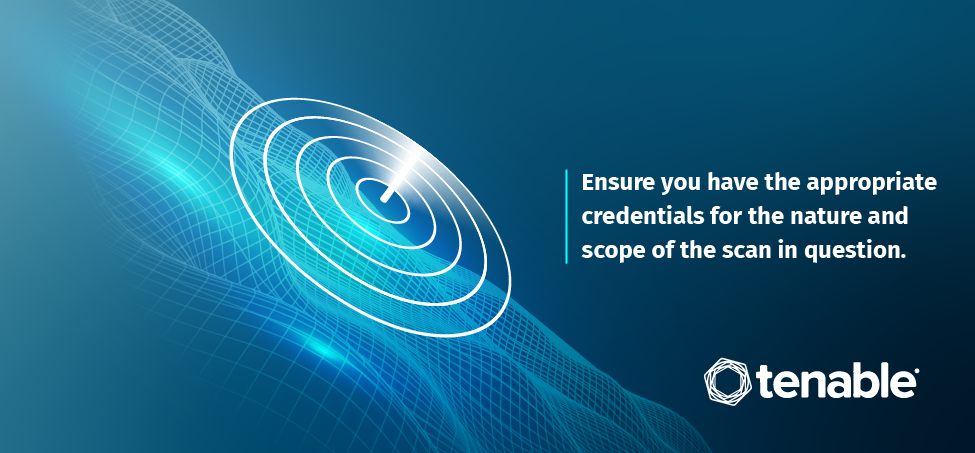4 Best Practices for Credentialed Scanning with Nessus

Observing these best practices for credentialed scanning will help you paint the clearest picture of your network's potential vulnerabilities.
Vulnerability scanning represents one of the most important tools for a modern organization to include in its information security arsenal. But as is true of many cybersecurity practices, it has its variations, chief among them being credentialed and non-credentialed scanning.
We don't want to take up too much of your time explaining why credentialed scanning is superior, which specifically stems from its comprehensiveness and accurate analysis. Instead, let's focus on how you can most effectively carry out credentialed scans and thus always remain fully aware of your organizational network's potential points of weakness.
Delegate (and revoke) credentials appropriately
Credentialed scanning entails conducting a vulnerability assessment through the use of a tool that's been granted a certain level of account access to look through hosts and program files containing sensitive information. Said credentials can technically belong to any authenticated account on the system. They don't have to be associated with the identity and position of the individual overseeing or authorizing the scan (or anyone else in the organization, for that matter). In fact, it will be most effective to create a dummy account with the appropriate permissions that solely exists to conduct credentialed scans, rather than granting the vulnerability assessment software the credentials of an actual high-ranking staff member.1
It's essential that vulnerability scanning tools always have the appropriate credentials for the nature and scope of the scan in question. (For Windows and Linux scans, they should be at the administrator or root level - although for Linux, root level is not always needed.) This allows scanners to access as many areas of the network as necessary, and root out common vulnerabilities and exposures (CVEs) wherever they may be hiding. That said, it's perfectly reasonable to alter credentials when scans aren't taking place, either by deleting the dummy account or disabling its access during these periods of inactivity.

Debunk the bandwidth myth
By virtue of its increased access, credentialed scanning's effectiveness in discovering vulnerabilities dwarfs that of non-credentialed scanning. Yet, there are still some IT administrators who are leery of credentialed scanning because they fear service interruptions as a result of increased traffic or are hesitant about how intrusive this type of assessment can be.
However, while it's important to limit the operational obtrusiveness of a scan as much as possible, the amount of traffic created in terms of packets sent is fairly low – often less than 1,000 packets – and much lower than that of a non-credentialed scan. A scan performed without appropriate credentials may send hundreds of thousands of packets while making queries necessary to find vulnerabilities.2 In stark contrast, credentialed scans generate far fewer packets because the tools executing such functions already have access permissions that a non-credentialed scan needs to "ask for."
That's why obtaining the right credentials for every scan is essential, so excess traffic isn't generated due to avoidable permission requests.
Scan in connection with patch releases
Research from Tenable has found that infosec and IT professionals discover a new CVE roughly every 90 minutes. On a broader scale, thousands of vulnerabilities of “high” and “critical” severity are disclosed every year. This is why applying patches as soon as they become available – and as quickly as possible – has become a fairly standard practice in infosec.
But if you allow personnel to manually patch rather than relying largely on automated updates, you may become concerned about certain departments falling behind on patches. Running a credentialed scan will quickly determine if any CVEs have slipped through any cracks resulting from missed patching opportunities and let you know what risks you've been exposed to. It also makes for an immediate action you can take in response to pressure from the C-suite about a new CVE that's made the tech headlines and raised concerns among senior staff. As a best practice, conduct vulnerability scans at least once a week - or ideally, twice.
Troubleshoot scanning issues quickly and appropriately
When a credentialed scan comes to its conclusion, you should have comprehensive results outlining the landscape of your network (or any section thereof) and detailing any CVEs or flaws discovered. From there you can start thinking about getting rid of those weaknesses and fortifying your network architecture against cyberattacks as much as possible. But what if there were problems with the scan? Results won't be as thorough and accurate as your organization needs.
Applying Occam's-razor logic to the problem leaves you with the likely answer: credentials weren't properly set up. Nessus Professional's authentication failure alert – plugin 21745 – quickly alerts you of this issue, so you can reconfigure permissions properly and run another scan. Proper management of your vulnerability scanning tools and credentials will ensure you always remain informed of (and prepared for) the latest, most alarming CVEs.
Learn about more ways to get the most out of your Nessus scans by downloading the ebook, 6 Ways to Optimize Your Nessus Scans.
You can start running credentialed scans today with Nessus Professional. Sign up now to get your free 7-day trial.
1. Security Boulevard, " 5 Best Practices for Credentialed Scanning," April 2018
2. Sikich, "Why You Should Perform Credentialed Scanning," July 2019
- Nessus
- Vulnerability Scanning
